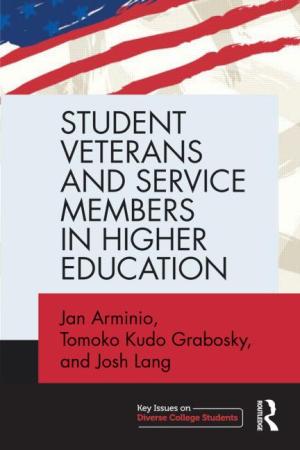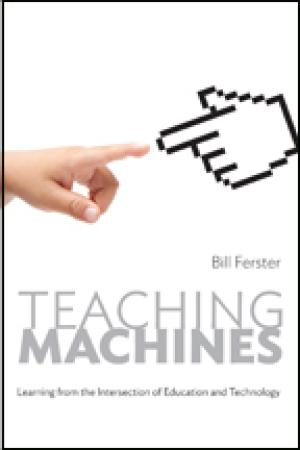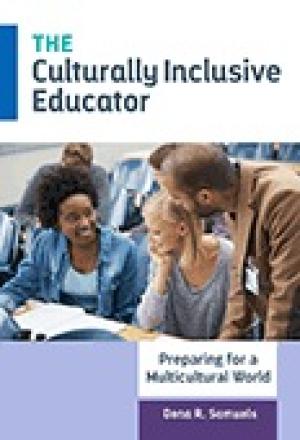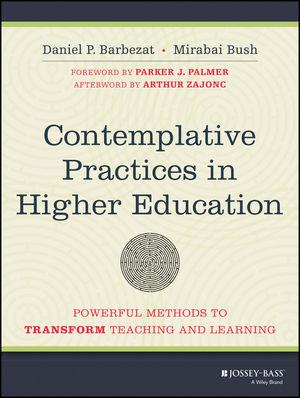Resources

Arminio, Grabosky, and Lang (2015) provide a comprehensive overview of student veterans and service members from interviews and analyses of higher education institutions. This book speaks from history and experience of the U.S. military to present outreach opportunities for the modern reader. The best audience for this book would be higher education administrators and counselors because it primarily discusses the challenges of transitioning to student life in higher education. More importantly, the authors consider the life of the students beyond school, what the students have seen, the makeup of the military world, and how it sheds light on this one. The study consisted of semi-structured interviews of sixteen higher education employees and fourteen students, and included a military spouse, and students at a community college and a public research-intensive institution with multiple campuses. Although this is a small set from which to draw specific conclusions, the volume provides valuable insights about service veterans and members enrolled in higher educational contexts. Student veteran and service members did not have direct support services at the research-intensive institution until after 9/11. The book documents how this change came about when students organized themselves and the campuses responded. The authors provide helpful lists of behaviors of facilitation (53) and advocacy of the student (61) and the system (65). Drawing on an advocacy model put forth by Lewis, Arnold, House, and Torporek (2002) of the American Counseling Association, Arminio, Grabosky, and Lang describe best practices in higher education for this target student group. For example, there should be regular review of degree progress corresponding to military financial benefits and possible deployment. The authors also give weight to possible needs for counseling and disability services. The three predominant cultural transitions between the military and higher education are the loss of collectivism, hierarchy, and masculinity. According to the study, student veteran and service members perceive themselves as outsiders in this environment (105). At the same time, "the military experience influences the college experience, but how it does depends on the individual and his or her experiences and contexts" (106). While the U.S. military is historically less tolerant of the LGBT community, one student participant in the study who identified as a lesbian felt accepted by her military colleagues (107). Higher education could further offer her the advocacy available at campus LGBT resource centers (89). If we continue to take her example, she still might find the individualistic culture of academics as a source of isolation when she once found quick comradery in the military world. A few of the interviews in the study mention that academics are a source of concern because they differ from the hierarchy and structure of the military in their exercise of power as teachers, with one person commenting that they prefer instructions for assignments to be more direct about resources and expected outcomes. A lack of specific directions can be disconcerting to past and present military-related students. Although the book gives insight into specific teaching styles for student veterans and service members transitioning into higher educational contexts, it does not offer as much as it might. On the whole, the book is geared toward the student as a part of the higher education community.

I decided to read Bill Ferster’s Teaching Machines: Learning from the Intersection of Education and Technology the summer that I offered my first online class. Ferster’s book, while by no means a “how to,” gave me much to consider as I entered this brave new world of online education. Ferster’s book is a history of the various ways that technology has been employed in teaching. The dream that Ferster points out has always been “Fordist” in nature, a mass production dream which attempts to replace the classroom teacher with some sort of machine substitute that can deliver educational objectives with the same outcomes as a human with greater efficiency and less cost. The path, Ferster shows, has been littered with failure, not only because the goal is problematic but also because the endeavor is mired in capitalism and governmental economies. Educational technologies have been too expensive for schools and failures at making a profit. However for those (like myself) engaged in using some form of educational technology, what is most striking about Ferster’s history is how the same problems have repeatedly vexed those applying technology to education. First and foremost is the problem of scale. How does one go significantly beyond some thirty students? Humans seem to learn by making mistakes. Figuring out where a mistake occurs and how to correct it is a complicated process that is not easily amenable to technological intervention; there are simply too many variables. Second, educational technology seems most appropriate for a rather narrow range of educational subjects: remedial math, spelling, and grammar are particularly benefited. But higher-level learning tasks like understanding a poem, writing a research paper, or engaging in art criticism (to name but a few) are outside the purview of what technology can really accomplish. Third, there has been no real change in education that technology has created; new platforms should create new ways of educating and not merely replicate the old ways in a different media. But thus far most technological solutions simply automate delivery of content in one form or another. The fact that much educational technology has no theoretical backing is related to this; there has been no clear advance in educational theory that technology can realize and often no educational theory at all has been considered in various programs and technologies. What is striking is that Ferster shows this is not just a problem with today’s online education or cloud computing; rather from the earliest attempts to apply mechanical technology to education the same issues have arisen. What Ferster’s readable history shows, at some fundamental level, is a need to rethink the real capabilities of educational technology. Ferster is somewhat sanguine about the ability of big data and artificial intelligence to address some of the more technical roadblocks that have stymied educational technology. That said, the larger problem, which the book seems to only skirt, is that the utopian dreams of replacing the teacher with a technological facsimile significantly misunderstands the role the instructor plays in the learning process. There is at some level a connection between the instructor and the student that promotes learning, accountability, and responsibility -- which cannot be replicated by technology now and may never be. Ferster’s contribution here is to make us think about these issues in a long historical view that highlights the real problems and promises of educational technology.

The Culturally Inclusive Educator: Preparing for a Multicultural World has the potential to complement and advance efforts of educational institutions and educators who grapple with becoming more inclusive. Dena Samuels’s work will convince those who have not begun this work to begin. Even more, it will equip them to do so. Agreeing with U.S. Secretary of Education Arne Duncan’s claims that “education is the civil rights of our generation” and that “great teaching is about so much more than education; it is a daily fight for social justice” (116), Samuels’ work demands both self awareness and institutional struggle. Because a “social justice journey is a marathon, not a sprint,” a training plan is required. This book is one such training plan. For the individual educator, Samuels offers numerous tips, including an extensive not-to-be missed list of inclusive educators characteristics (108-9). Yet, for all the difference individual educators can make, in order to make the deepest impact, this “bottom up” approach (e.g., addressing microagressions in the classroom) must be combined with a “top down” commitment (e.g. recruit and retain diverse faculty and administrative leadership, develop inclusive curricula, demand rigorous assessment of diversity trainings). Samuels stresses institutional diversity practices instead of relying solely on “individual champions who come and go” (76). Samuels is hopeful even as she admits that becoming culturally inclusive educators and educational institutions is a long-term and, at times, difficult venture. She speaks from the experience of investing in the process. I have learned that my skin color . . . represents something, whether I want it to or not . . . when I become aware of my easily manifested entitlement, I tangibly feel the sting of inequality, even as the recipient of unearned privilege. It is important that I have deeply felt this pain, not as White guilt, but as a reminder that these systems of inequality affect us all, obviously to different degrees, and that my objective is to dismantle them (90). Some readers will be introduced to new vocabulary such as microaggression, noun-based identifiers, nondominant (instead of minority), meritocracy, and code switching. Others will be surprised by research results. For example, studies have found that voluntary inclusiveness trainings may produce more inclusive behavior than mandatory trainings (43), and that training faculty when they are in graduate programs is more beneficial than when they are in their teaching positions (44). Yet others might be surprised to hear that faculties and institutions are not as prepared as they think they are (24). Minimally, readers will gain much from the extensive bibliography, helpful appendices, and references to various survey instruments. Other than a desire to read more about instances of institutional and classroom success, I am satisfied with this book’s ability both to convince me that my own “minor actions can make a major impact,” and to encourage and guide me toward amending my practices and the practices of our educational institutions.

Nancy Lynne Westfield Associate Professor of Religious Education Drew Theological School The projects have, at sometimes, crashed and burned. There have been the occasional minor derailments. In several instances there were irreconcilable differences and un-repairable circumstances. Once I declared utter, dismal failure. On the other hand, there have also been...

Molly Bassett Associate Professor of Religious Studies Georgia State University In my first post, I described a new course-- “Religious Dimensions in Human Experience: Between Animals and Gods” -- and all of the teaching activities I have going on in it: there was planning and now teaching, writing this blog,

Nancy Lynne Westfield Associate Professor of Religious Education Drew Theological School “Learning on the fly,” a phrase used by seminarian Phil Salter, is still on my mind. I am taking a different tact from my previous ponderings …. The inclinations, proclivities and aspirations to fly are abundantly evident in literature

Molly Bassett Associate Professor of Religious Studies Georgia State University It’s week nine here and this is my seventh post for the Center’s blog on teaching. We’ve reached the point where I’d like to take you out for coffee and find out how it’s going. I’d love to hear about...

Theological school deans are not just theological leaders for their institution, they must be EDUCATIONAL leaders. That is, they must implement sound educational practices related to curriculum, instruction, supervision, assessment, and administration. There is a variety of ways to assess...

We live and teach in a world of massive distraction. It is difficult to find spaces or times in which people are simply still, let alone inhabit silence. College students claim they are effective “multi-taskers” but more and more research is suggesting that multitasking is not a route to deep learning, and can even begin to shape attention practices in detrimental ways. What can we do? One generative inquiry into these challenges comes from the field of contemplative practice. What is contemplative practice? The authors of this book define it broadly, noting that these practices certainly include meditation, but not all are meditative in the traditional sense. . . . They all place the student in the center of his or her learning so that the student can connect his or her inner world to the outer world. Through this connection, teaching and learning is transformed into something personally meaningful yet connected to the world. (6) Bookended by a foreword written by Parker Palmer, and an afterword by Arthur Zajonc, this book is a much needed and pragmatic resource for anyone teaching in a higher education context. It is based on nearly twenty years of research into contemplative practices in higher education, including the work of 152 fellows who worked on classroom experiments in more than one hundred colleges and universities. Barbezat and Bush provide a concise but thorough overview of this research, while keeping their focus on teaching and learning practice. The book is divided into two sections, the first concentrating on theoretical and pedagogical background, the second a guide to contemplative practices in higher education classrooms. Issues such as neuroplasticity, the challenges of reflecting on first-person experience, and a range of theoretical resources for introducing and developing meditation and introspection are explored in the first section. In the second section the authors draw from a vast array of pedagogical experiments in a diverse assortment of disciplines to resource specific exercises in mindful reading, writing, listening, movement, and action. These resources include specific writing prompts, examples of syllabi, and a rich collection of bibliographic entries for further study. The authors also address directly the challenge of the religious studies classroom: “The most problematic place in the academy to introduce contemplative practices has been religion departments, where the concern has been that a professor who practices the religion he or she is teaching would not be sufficiently objective. Teaching contemplative practices to students raises a further concern: proselytizing” (105). Here the authors are quick to point out that contemplative practices of this sort are about “students discover[ing] their own internal reactions without having to adopt any ideology or specific belief” (6). But is this really an appropriate response? My primary critique of this significant book is to ask what it means to invite students into a “technology” of embodied practice without at the same time inviting them to inhabit the beliefs within which that technology arose. Are we really willing to remove context in this way? Or is the contextual collapse we are already living within (cf. Michael Wesch) necessarily confronted by the intentionally attentive work of contemplation? Can practices of meditation and introspection so ground our knowing as to build the kind of insight, compassion, and systemic analysis necessary for living in a deeply present way in our postmodern world? There are likely no clear or single answers to these epistemological conundrums. As one of the teachers whose work is explored in the book, Mary Rose O’Reilly, writes: “I learned that the single most important thing a contemplatively centered classroom teaches the teacher is not a pedagogical recipe but pedagogical flexibility” (188). For my part, I am hopeful and energized by the various experiments with which these innovative educators are engaged. Given that education must, at heart, “create environments for students to inquire and challenge themselves about the meaning of their lives and the lives of others” (200), this book offers both rich reflection and pragmatic resources for doing so.

Himanee Gupta-Carlson SUNY Empire State College Shortly after the verdicts in the Ferguson and Staten Island police beating cases led to protests via social media and demonstrations across the country, I found myself involved in two conversations. The first occurred with a car mechanic in Saratoga Springs, the small rural New York community where I work. The mechanic, an African American, described the encounters between the African American males and police officers as well as the citizen protests as signs of unremitting violence. He relayed a racially coded incident with local police in which a man was pulled over, rightfully,
Wabash Center Staff Contact
Sarah Farmer, Ph.D
Associate Director
Wabash Center
farmers@wabash.edu